You pour your heart and soul into your business and content marketing efforts. You think you’ve left no stone unturned and still find yourself losing to others in valuable rich results. Google’s recent changes have pushed SEOs and marketers to focus on including and optimizing for relevant entities. This means that business information needs to be fresh, updated regularly, and above all, accurate.
The Google knowledge graph bridges the gap between your website and qualified search traffic. Optimizing for key listing areas only provides your site with more recognition and eligibility to be used in more widespread rich results. Let’s dive right into what you need to know and how to effect change with Google’s knowledge graph.
Want better organic visibility in AI summary search?
What is Google’s Knowledge Graph?
Google’s knowledge graph database has data about people, places, and things and how they are interconnected and related to one another. Google has increasingly been referring to this data as “entities”. This information helps Google provide users with specific information and allows the search engine to align and relate businesses and their content to one another to understand relationships.
Put simply, Google uses this information to understand where to rank and include your business in a variety of search features and knowledge panels.
Knowledge Graph vs Knowledge Panel: What’s the Difference?
Knowledge Graph:
Knowledge Graphs are not something you can see. Google Knowledge Graphs is a far-reaching database that is continuously updating with new information that can be served in Knowledge Panels.
Knowledge Panels:
Knowledge Panels are results you can see. These are focused on providing users with concise information lifted from Google’s Knowledge Graph database.
The Importance of Knowledge Graph Optimization
Optimizing knowledge graph information is essentially updating the information Google has available to serve on your behalf in knowledge panels and rich results. Keeping things updated in the eyes of Google not only keeps you ‘top-of-mind’ but also tailors your information to your users, giving you a better chance of being included in prominent search placements.
Here’s why knowledge graph optimization is so important:
- Prime Real Estate in Search: Having a well optimized knowledge panel, pulling from fresh data in Google’s knowledge graph, is like having the biggest billboard on the side of the highway. The highway is going to have cars on it every day, but the billboards are always changing.
- Increase Trust & Credibility: The more prominent your results are, the more trust you will gain among searchers. Having a well-structured panel can help showcase your expertise, industry awards, and more.
- Improved User Engagement: Having results that provide good summaries and quick interactions will improve overall user engagement. User engagement metrics are more important than ever and will have an impact on your overall SEO health.
How To Optimize For Knowledge Graphs
1. Build A Strong Website Foundation
It would be irresponsible to start off a list without first establishing that you need to have a strong website foundation. Google, above all, prioritizes accuracy and information built for users rather than search engines. While many of the optimization tactics may feel ‘surface-level’ never underestimate the power of search engine optimization basics before heading to more advanced techniques.
- Build Topical Authority with Content Clusters: Be implicit with what content you produce and how it’s structured in relation to the rest of the website. Creating these buckets of content help Google and users understand these content relationships. Not only is this a benefit from a ranking perspective but it also aids in user engagement. Content with clear relationships does a better job at keeping users on page and encourages website exploration.
- Internal Linking Structure: Create a clear structure and hierarchy for your content and website. The easier it is for Google and users to find and understand information, the higher the chance of key information being lifted and repurposed on your behalf.
- Fresh Content & Ideas: Write for the user and not the search engine. Whether or not you’re tired of hearing that statement doesn’t negate how crucial it is. Try writing content without a content brief and keyword research purely based on the SERP. Tackle issues happening now instead of recreating something already written by a competitor.
It goes without saying that there’s a need for on-page optimizations, mobile friendly websites, and keyword research. Ensure all basic SEO elements are well-structured, clear and optimized before moving on.
2. Use Schema Markup
Use the “Organization” schema to help you add a layer of clarity to where your business should be listed and how to refer to key elements. There are a plethora of property types that can be used within an organization and should be taken into consideration when building out your structured data.
In addition to the organizational structured data, you can use the chart below to identify any additional schemas that could help elevate other sections of your site.

Find & Validate Current Structured Data
If you want to get a sense of what structured data you already have on your site and the prevalence of errors, you can use Google Search Console. On the left-hand side, you’ll see a section titled “Enhancements. This is where Google reports on what data is readily available on your site and its associated health.

3. Reputation Management
Reputation management means more than responding to reviews and keeping information up to date. Managing your reputation online took on new meaning as Google sharpened their entity understanding. Your business reputation goes beyond authority scores and involves information across the web from a multitude of sources.
Some steps you can take to mitigate reputation deterioration are:
1. Google Business Profile Optimization
Claiming and verifying your Google Business profile is an elementary step in the reputation management process but remains critical. Ensure your business profile is fully filled out with updated information. Providing regular updates here can help Google recognize your listing.
Reviews and customer sentiment are the bread and butter of your business profile and should be monitored to match the frequency of responses. Encouraging satisfied customers to leave a review is the best indicator of reputation.
2. Get Listed & Optimize on Google’s Source Websites
Google has long taken information from key source websites they trust to supplement information found on company websites. Getting listed on one of the following websites, wherever your business might be mentioned, will only help Google’s understanding of your business and how it connects to other entities.
- Wikipedia
- Crunchbase
- Bloomberg
- Yahoo
3. Reddit & Quora
The rise of Reddit and Quora responses in search has taken marketers by storm since the March 2024 algorithm update. Do a quick search for your company name, services, or products. You’ll be amazed at what you might find. Treat these just like customer reviews on your business listing, each post should get a response.
These might not have as much direct impact on your reputation as being listed on verified Google source sites, but considering that negative threads can be shown right next to your own organic results can cause a change in customer/user sentiment and behavior. Keep an index of positive and negative reviews from these sites so you’re always up to date with how people are referring to your business.
4. Build Relevant Entity Partnerships & Backlinks
Sometimes being included in rich results and knowledge panels is reliant on things outside of our control. The image below is the result for the search “startup marketing agencies”. We understood that being listed in this section was reliant on our brand name being used in listicle write ups and review sites.

To optimize for this entity placement, we knew we’d have to build partnerships with the right sites to be included in the results. Tactics change depending on results but after we’re properly associated with the other entities in this list, our brand finally pop-up in this aggregate results. It’s important to understand who the players are when it comes to getting proper placement because sometimes it can be a group effort.
5. Claim Current Listings
If a knowledge panel is created about an entity you own, you can claim the panel and suggest edits to it to keep information current. You’ll have to go through the steps of verifying your ownership to Google but the effort is well worth it.

By claiming and managing the information on these listings, you are creating more connections in the backend of Google Knowledge Graph so they can better understand how widespread the information about your business is.
Don’t Go In Alone
If you’re stuck trying to figure out how to get better visibility for your brand or business, you don’t want to attack this issue alone. Partnering with a skilled SEO team is going to maximize results and cut down on wasted testing time. While every business is unique and requires different approaches, having a knowledgeable team behind you is your fastest path to success.
At NoGood, we specialize in future-proofing SEO efforts and AI summary search tactics. If you want to learn more about how we can help you achieve organic success, drop us a line!






